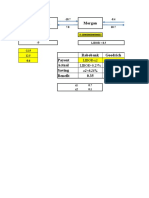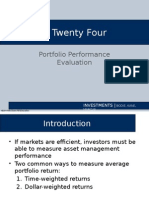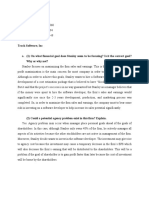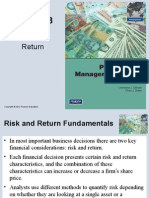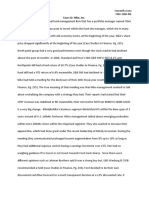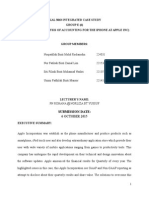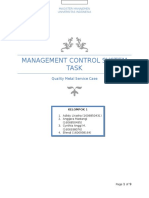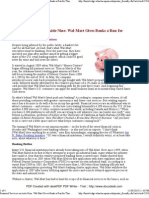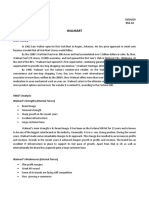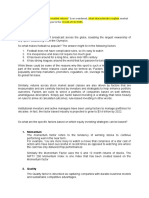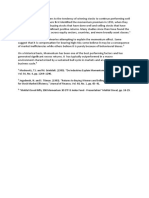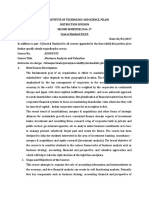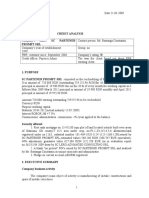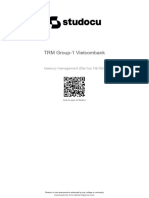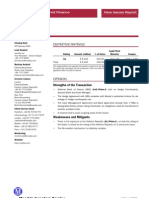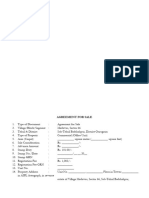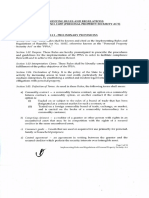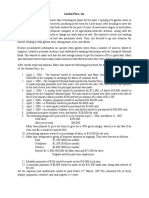Derivatives & Risk
Management
Case Study: Walmarts Use of Interest Rate Swaps
� Walmarts emergence as a global behemoth began
with the opening of the first Walmart store by Sam
Walton in 1962 in Rogers, Arkansas.
Introduction
Walmarts success was due to a disciplined adherence
to the strategy of purchasing high volumes directly
from manufacturers combined with pioneering
investments in information technology that allowed it
to effectively manage its supply chain and distribution
networks.
Walmart closed the twentieth century as the United
States largest generator of sales and the worlds
largest private-sector employer.
It targeted an increase in its share of U.S. retail share
sales from 8% to 15%.
� To reach this target, Walmart company officials bet on
growth of its Supercenter stores, which were larger
versions of its flagship stores that added groceries to
the normal product offerings.
Introduction
Having firmly established itself as the prominent U.S.
retailer, Walmart sought to build on its international
expansion.
In 2000, Walmart announced that international sales
would account for 30% of total sales by 2005.
�Net Sales (in Billions)
312
285
Growth and
Challenges:
2000 -2005
244
256
217
191
165
2000.0
2001.0
2002.0
2003.0
Net Sales
2004.0
2005.0
2006.0
�Walmart Stores
1980
Growth and
Challenges:
2000 -2005
1736
1713
1647
1568
1478
1353
1258
1066
942
982
2002.0
2003.0
888
612
648
2000.0
2001.0
Discount Stores
Supercenters
1431
1175
1209
2004.0
2005.0
International Stores
�Growth and
Challenges:
2000 -2005
� Between 2000 and 2005, Walmart raised $26.3 billion
from bond issuances and only $581 million from
equity issuances.
Walmarts long-term debt grew from $18.8 billion in
2000 to $35.1 billion in 2006, an increase of 87%.
Walmarts
Reliance on
Debt
In connection with its bonds, Walmart also entered
into interest rate swaps, which impacted its exposure
to changes in market interest rates.
The proportion of Walmarts fixed-rate debt that was
exposed to floating rates as a result of Walmarts
interest rate swap activity increased steadily from
5.8% in 2001 to a high of 51.3% in 2004.
Walmart typically swapped the fixed rate payment
obligations on its outstanding debt for payments that
would fluctuate with London Interbank Offered Rate
(LIBOR).
�Walmarts
Reliance on
Debt
�Walmarts
Reliance on
Debt
November 16, 2004 Q3 2005 Conference Call:
While we are all pleased to see that the general
improvement in the economy has been strong enough
to trigger the Fed to raise interest rates, rising rates
will obviously have an adverse effect on our
borrowing costs.
�Analysis
At the end of Wal-Marts 2001 fiscal year, during
which the yield curve was inverted on average
(specifically, the average 1-year Treasury yield was
higher than the average 10-year Treasury yield by 9.5
basis points making floating rates higher then fixed
rates), Wal-Mart had swapped only 3.9% of its debt
from a fixed to a floating interest rate exposure,
resulting in an overall floating debt exposure of
18.7%.
During the 2002 fiscal year, the average Treasury
yield spread (the 10-year Treasury yield minus the 1year Treasury yield) had risen to 1.75%, making
floating rates significantly lower than fixed rates. WalMart commensurately increased its pay-floating
interest rate swaps to 17.3% of its debt, bringing
25.3% of its debt to a floating exposure.
� The Treasury yield spread rose even further during
the 2003 fiscal year, to an average of 2.59%. WalMart again increased its pay-floating interest rate
swaps to 32.6% of total debt, resulting in 40.8% of its
debt with a floating exposure.
Analysis
In fact, its interest expense fell by $269 million
(18.5%) even though its total debt increased by $3.5
billion (16.1%). Their resulting earnings exceeded
their consensus analyst earnings per share forecast
by three cents in 2003.
Consistent with the steep yield curve of 2003, by the
end of Walmart's 2005 fiscal year, short-term interest
rates had risen considerably. This higher interest rate
environment led Walmart to issue an earnings
warning stating that it expects interest expenses to
raise as much as $500 million this year, due in part to
higher interest rates that could hurt earnings by eight
cents a share
�Analysis
In effect Wal-Mart chose to drastically reduce their
interest expense from 2002 to 2003 by swapping to
floating when they could have locked in low fixed
rates and avoided the anticipated increase in floating
rates that materialized in 2005.
This strategy resulted in a near term gain in 2002 at
the expense of future earnings in 2005.





